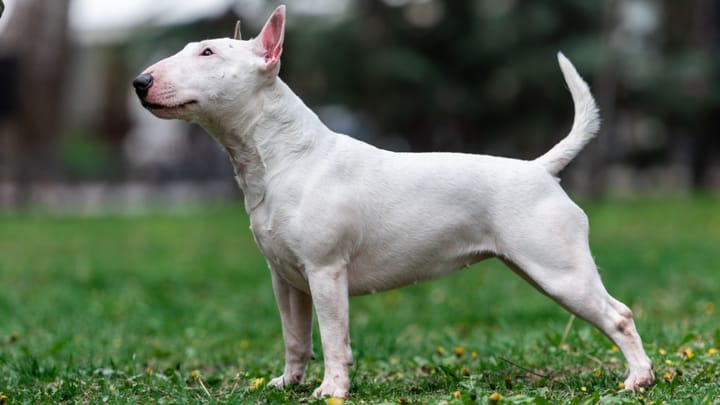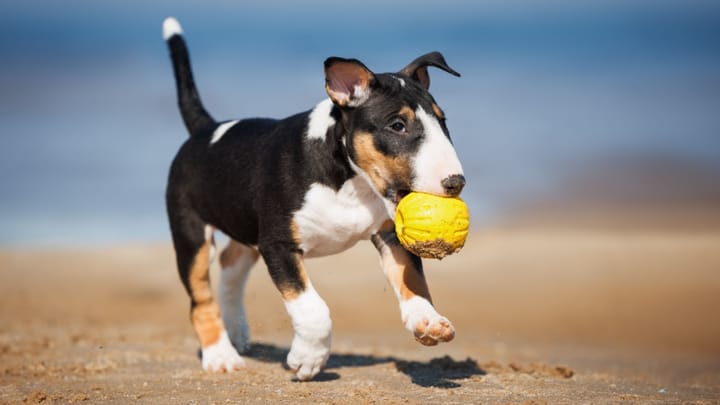Bull Terrier
Other names : English Bull Terrier, Standard Bull Terrier, Miniature Bull Terrier


A compact, muscular and energetic dog, the Bull Terrier isn’t dangerous, contrary to popular belief. This dog may be overly excitable at times, but remains an adorable, happy and extremely loyal dog. Modern breeding practices have softened the breed’s aggressive side. The Bull Terrier will need an experienced, active and available owner who can provide this big ball of energy with everything it needs.
|
Life expectancy |
The Bull Terrier has a life expectancy of between 10 and 14 years |
|
Temperament |
|
|
Size |
Medium
|
|
Adult size |
Female
Between 14 and 20 in
Male
Between 14 and 20 in
|
|
Adult weight |
Female
Between 44 and 88 lb
Male
Between 44 and 88 lb
|
|
Coat colour
Usually completely white, the Bull Terrier’s coat can also sport black markings or brindle. Fawn brindle and fawn tri colour also exist. Blue and brown Bull Terriers do not adhere to the breed’s official standards. |
White Black Brown Brindle |
|
Type of coat
The coat is very short, even smooth. The Bull Terrier’s coat is shiny, flat and hard to the touch. A soft undercoat appears during the winter. |
Very short |
|
Eye colour
Either brown or black, the eyes should always be very dark. Blue-eyed subjects are not recognised by the breed’s official standards. |
Brown
|
|
Purchase price |
The Bull Terrier costs between £860 and £1170 |
The standard Bull Terrier and its miniature counterpart are not to be confused. They are considered as two completely different breeds and have differing official standards. Nevertheless, their size is their only differentiating factor, as they are the same behaviourally.
The Miniature Bull Terrier should not be more than 14 inches tall, and the standard breed no more than 20 inches.
More details about the Bull Terrier
Bull Terrier: Origins and history
The Bull Terrier originated from the Manchester Terrier and English White Terrier, the latter no longer existing. The Bull Terrier’s famous white coat was the only colour accepted by the breed’s official standards for a very long time, and it is still extremely common. James Hink, considered as the ‘father’ of the breed, added Dalmatians into the Bull Terrier’s bloodlines to create the dog we know today. His work was continued by his children Fred and James as well as his grandson Carleton, son of James Jr., who started breeding under the “Brum” name, the most famous in the world. It was he who created the “Roman nose” for the first time for his champion Lord Gladiator, who then passed this trait down to his descendants.
Physical characteristics of the Bull Terrier
It’s difficult to mistake this dog for anything other than a Bull Terrier, thanks to its unique egg-shaped head. This profile, known as the “Roman nose”, is one of a kind. The Bull Terrier’s physique is almost gladiator-like: robust, compact and muscular.
Bull Terrier: Varieties
- Standard Bull Terrier
- Miniature Bull Terrier
Bull Terrier: Characteristics
Bull Terrier: Behaviour
Training a Bull Terrier
Training Bull Terriers can be tricky as they’re naturally quite stubborn. Their unwavering energy also means that it can prove hard for them to concentrate. Training sessions should therefore be short, but regularly repeated until they obey the command.
Your Bull Terrier should receive basic training as young as possible to avoid picking up bad habits.
You will need a firm hand to train this dog while being careful not to show aggression, so as not to elicit the temper of this fighting dog. Kindness, patience, coherence and regularity are the keys to successfully training a Bull Terrier.
Bull Terrier: Lifestyle
Breed compatibility Bull Terrier
Bull Terrier: Purchase price
The price of a Bull Terrier depends on its origins, age and sex. You should budget between £860 and £1165 for a dog registered with the KC.
Concerning your monthly budget, you should set aside around £40-£50, which will cover a premium-quality diet, as well as classic annual treatments such as vaccinations, deworming and anti-parasite treatments.
Bull Terrier: Shedding
Average
A weekly brush will be necessary to get rid of the minimal (but still present) dead hair.
Bull Terrier: Grooming
This dog’s smooth coat makes it very low-maintenance; however, grooming should still be regular.
You should use adapted products to wash your dog, as the Bull Terrier has sensitive skin and is thus prone to allergies.
Eyes and ears should also be frequently monitored and cleaned.
This dog also needs to get used to the filing and cutting of its claws. Since the dewclaw doesn’t touch the ground and therefore isn’t naturally filed down, it should be trimmed regularly.
Bull Terrier: Health
Their lifespan is around 12 years.
This muscular dog is very resilient, and has quite a high life expectancy, but is known to suffer from some health problems all the same.
This terrier deals well with heat, but can easily sunburn. You may have to apply an adapted sun cream to the parts of its body that does not have hair.
In winter, this dog develops an undercoat that provides it with a certain resilience to cold climates, but not enough to be left outside.
This dog has a very large appetite. Therefore, if it isn’t provided with a healthy, rationed diet, it can easily put on weight and lose its muscular frame.
- Skin disorders (allergies, pyoderma)
- Epilepsy
- OCD (obsessive compulsive disorder)
- Kidney problems
- Deafness
- Cardiac problems
- Dislocation of the kneecaps
- Hip dysplasia
- Bull Terrier Lethal Acrodermatitis du Bull Terrier (fatal genetic metabolic disorder)







